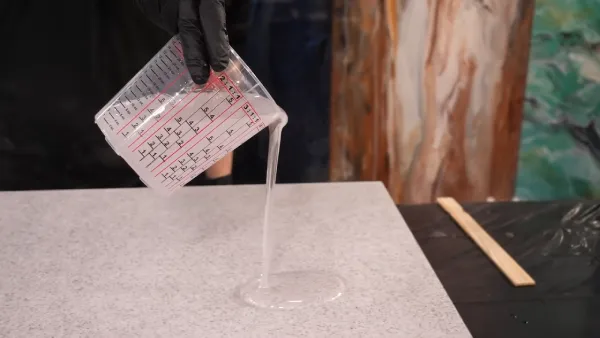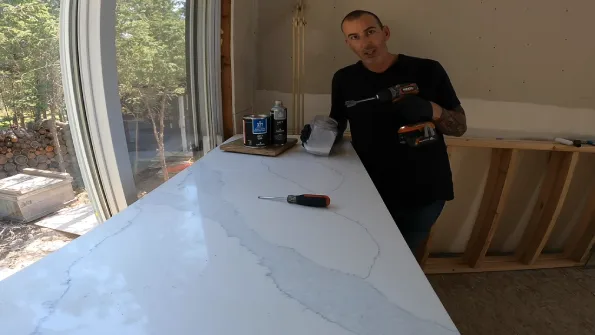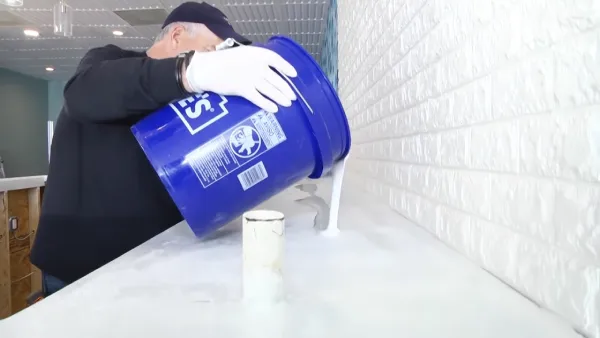Last Updated on February 1, 2023
Are you looking for a way to upgrade your kitchen countertop? Have you considered using epoxy to seal it? Sealing concrete countertops with epoxy is a great way to add a sleek, highly durable and attractive finish.
Epoxy helps protect the surface from staining and wear, while also creating an aesthetically pleasing look.
This post will discuss the benefits of sealing concrete countertops with epoxy, as well as provide some tips on how to complete this project successfully. Read on for more information about this exciting home improvement project.
Can I Seal a Concrete Countertop with Epoxy:

Preparation for Applying Epoxy
Before you apply the epoxy, there are certain steps you must take in order to ensure that the end product is as durable and high-quality as possible. Check out the following instructions for preparing concrete countertops for epoxy application.
Clean the Surface Thoroughly
One of the most important steps in preparing a concrete countertop for application of an epoxy coating is cleaning the surface thoroughly. This involves removing dirt and dust from the surface of the concrete with a vacuum or wet rag.
The cleaner that the surface is when it’s time to start applying the epoxy, the better your results will be. If there are any stubborn areas of dirt or grime that can’t be removed with light scrubbing or vacuuming, then you may need to use a stronger detergent in order to get rid of it completely.
Fill in Any Cracks or Holes
Another key step when preparing a concrete countertop for application of an epoxy coating is filling any cracks or holes that might exist in the surface of the concrete. This can help ensure that no moisture can get trapped under the epoxy coating which could lead to early deterioration down the line.
To do this properly, you should use a specialized cement-based filler specifically designed for sealing cracks in concrete surfaces like countertops and other horizontal surfaces.
Once applied according to instructions on its packaging and allowed enough time to dry completely, you can then be sure that your surface has been properly sealed against water damage before applying any type of protective layer such as an epoxy coating over top it.
Sand the Surface Smoothly
The next step in prepping a concrete countertop for application of an epoxy coating is sanding down any rough spots or bumps on its surface until it’s smooth all over.
It’s important to make sure the surface of your wall is flat and even before painting it. This prevents any imperfections from showing through and causing weak spots or water damage that can cause the paint to wear away over time. A smooth surface will make sure your protective layer stays strong.
When sanding your concrete countertop, use fine-grit sandpaper. This will help to avoid leaving too much residue that could stop the protective layer from sticking well when it is installed.
Dry the Surface Completely Before Application
After these initial preparatory steps have been completed, it’s then essential to allow adequate time for this freshly cleaned and sanded piece of concrete workspace to dry out completely before beginning applying your protective layer such as epoxy resin over top it .
This helps reduce chances of moisture interference between layers during installation process which again if left unchecked could result in premature deterioration due water absorption through weak points created by small pockets trapped air etc .
Make sure at least 24 hours have passed since last time was cleaned and sanded , thereby giving ample opportunity to evaporate out remaining water present between layers prior being sealed off by new polymer based protective coatings like those found within range of our professional grade two part products.
Application Process of Epoxy on Concrete
When used correctly, epoxy can make your concrete countertop more durable and help you avoid costly repairs down the road. To ensure quality results, we will discuss the application process of epoxy on concrete here.
Choose Appropriate Type and Color of Epoxy
Choosing the right type and color of epoxy for your concrete countertop is important for achieving the desired aesthetic as well as ensuring it is adequately protected. The two main types of epoxy are water-based and solvent-based, both of which have pros and cons depending on your needs.
Water-based epoxies tend to be easier to apply but solvent-based epoxies have better adhesion properties and durability. As for color, there are many options available including clear, white, black, metallic finishes, or even custom colors if desired.
Apply Primer Coat According to Manufacturer’s Instructions
Before applying the first layer of epoxy, it is important to apply a primer coat according to the manufacturer’s instructions. This step helps ensure that the surface is properly prepared before any further coats are added.
Primers usually come in either water- or solvent-based formulas so make sure you choose one that matches what you will be using for the main coats. Additionally, some primers must be diluted before application while others may require multiple coats in order for optimal performance.
Prepare Area and Apply First Layer of Clear Sealant
Once the primer coat has been applied according to the manufacturer’s instructions, it’s time to prepare the area for applying the first layer of clear sealant. Make sure all dirt or dust particles have been removed from the surface using a wire brush or damp cloth prior to beginning application.
Then measure out equal parts A & B components according to manufacturer’s directions then mix them together thoroughly until they reach an even consistency before adding them onto your surface with a paintbrush or roller depending on what kind of finish you desire (glossy or matte).
Allow Time for Curing Between Applications
After applying each successive layer of sealant, allow enough time to cure before starting another coat; usually around 24 hours between each one is sufficient but always follow manufacturer’s instructions as different products may vary in this regard.
During this curing time period also keep away any strong heat sources such as open flames or direct sunlight since these may cause discoloration if left too long during curing process
Finish with Final Topcoat To Complete Sealing Process
Once all layers have been applied according to manufacturer’s instructions it’s time for finishing off with the final topcoat which provides additional protection against scratches and wear over time along with giving it additional shine or matte finish depending on individual preference when selecting topcoat product at beginning stages .
Make sure that all previous coats have fully cured before applying topcoat then apply evenly using appropriate tools such as brushes/rollers depending on type again following product directions closely .
Once complete allow topcoat adequate amount of drying/curing time (usually 12-24 hours ) then enjoy your newly sealed concrete countertop!
Tips and Tricks for Maximum Durability and Quality Finish

To get the most out of this process and achieve maximum durability, there are certain tips and tricks you should keep in mind when using epoxy to seal a concrete countertop. Let’s explore some of these tips below.
Consider Using Non-Slip Additives for Safety Purposes
Safety is always important in any construction project, especially when installing or refinishing concrete countertops. One way to ensure safety while using epoxy on the surface is to add non-slip additives into the mix before applying the topcoat.
This will provide additional traction and grip on top of the surface, making it much safer for those that may be walking across it once finished. Furthermore, if you plan on having food or drinks on the surface it can reduce potential spills as well.
When adding non-slip additives be sure to follow any instructions provided by the manufacturer for best results.
Use a Brush, Roller, or Squeegee to Evenly Distribute Topcoat
When applying epoxy to seal a concrete countertop it’s important that you use either a brush, roller, or squeegee to evenly distribute topcoat across the entire surface area for best results.
This will help ensure that epoxy is fully adhered to both sides of each joint as well as helping avoid any air pockets or inconsistencies in application along with preventing “fisheyes” (small droplets appearing after application) which can have an adverse effect on the final finish and quality of your countertop.
Keep Environmental Conditions in Mind when Working with Epoxy
It’s also important to keep environmental conditions in mind when working with epoxy such as temperature and humidity levels as they can have an impact on how long it takes for it to cure properly or not allow it to cure at all depending on how extreme they are during application time-frame.
Generally speaking most manufacturers recommend temperatures between 65⁰F – 75⁰F (18⁰C – 24⁰C) and humidity levels below 80% but this may vary from product type so be sure to double check specific instructions for best results.
Lastly make sure that any air flow within your workspace doesn’t create drafts which could cause premature drying during application time-frame resulting in poor adhesion properties which would affect overall quality of your finished product.
What is the best way to seal concrete countertops?
The best way to seal concrete countertops is to use an acrylic-resin based sealer. This type of sealer provides a high level of protection and sealing power that prevents moisture, stains, and other liquids from penetrating your countertop surface.
Once applied, these sealers form a hard protective layer that can last up to 5 years or more with the proper application and maintenance. Additionally, acrylic-resin based sealers are available in gloss, matte, and satin finishes so you can customize the look of your countertop accordingly.
What do you finish concrete countertops with?

Concrete countertops can be finished using a variety of materials such as acrylic resins, lacquers, epoxy resins, waxes, polyurethanes, or even tile grout. Each of these materials have different benefits depending on what you’re looking for in terms of aesthetics and durability.
For example, if you’re looking for a glossy finish then an epoxy resin would be best while lacquer would provide a more durable finish that will last longer than the other options listed above.
Do I need to seal outdoor concrete countertops?
Yes! Outdoor concrete countertops require sealing just like any other outdoor surface to protect it from weathering and staining due to rain and snow.
A quality acrylic-resin based sealer should provide adequate sealing power while still allowing the natural beauty of your outdoor concrete countertop to shine through in all its glory!
Additionally, when applying the sealer make sure it is thoroughly dried before exposing it to moisture which will increase its longevity even further!
When should I seal my concrete countertop?
It is recommended to apply a sealer immediately after installing your concrete countertop as this will prevent any water or oil-based spills from seeping into the porous material and cause discolouration or staining on the surface.
Additionally, re-sealing every 5 years or so is also recommended in order to maintain the optimal protection offered by waterproofing agents found in most quality acrylic-resin based sealers.
How long does epoxy resin last on concrete?
Epoxy resin is an incredibly durable material which, when applied correctly to concrete surfaces, can provide lasting protection. The exact lifespan of an epoxy resin coating on concrete depends on a few factors, including the quality and thickness of the application as well as environmental conditions such as temperature, humidity, and exposure to ultraviolet (UV) light.
Generally speaking, a properly-applied epoxy coating can last for 10-15 years or more. In addition to protecting against wear and tear from pedestrian traffic, outdoor epoxy coatings for concrete can also protect against moisture penetration and the growth of mold and mildew.
Conclusion
Overall, sealing concrete countertops with epoxy is a great way to enhance the look of your kitchen while also protecting them from damage and wear. The application process is relatively simple, though it does require patience and precision in order to achieve the desired results.
With proper preparation and careful application, you can create a beautiful, highly durable finish that will last for many years to come. So if you’re looking for an easy yet effective way to upgrade your kitchen countertop, try sealing it with epoxy today!



